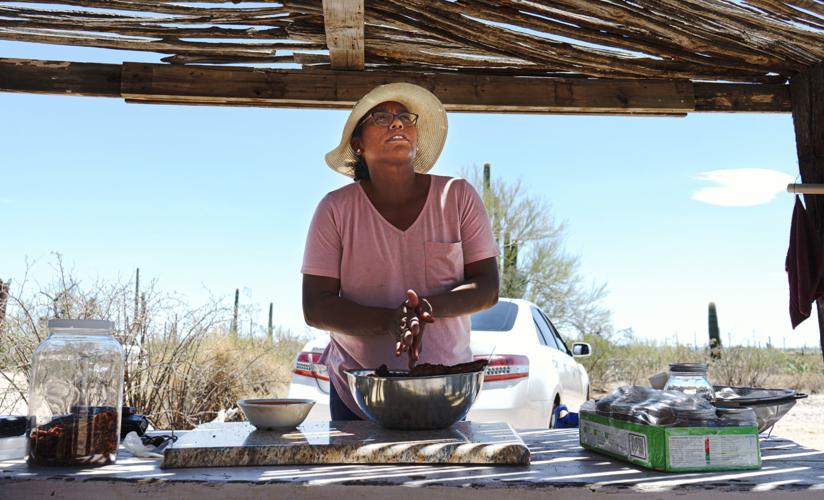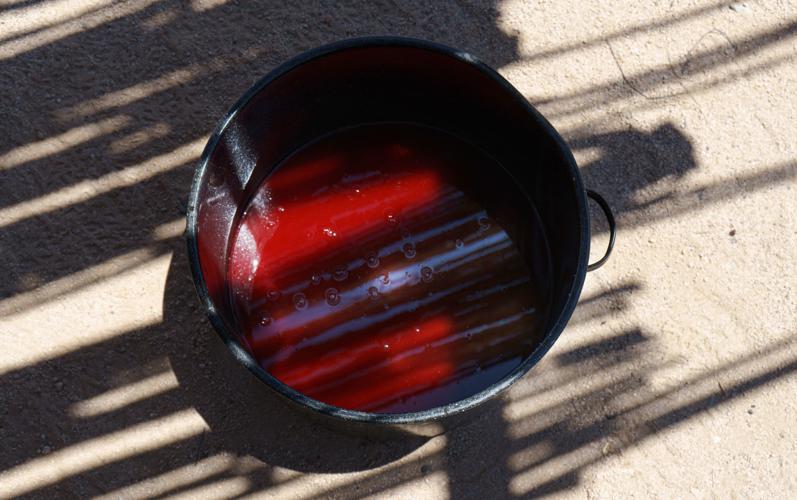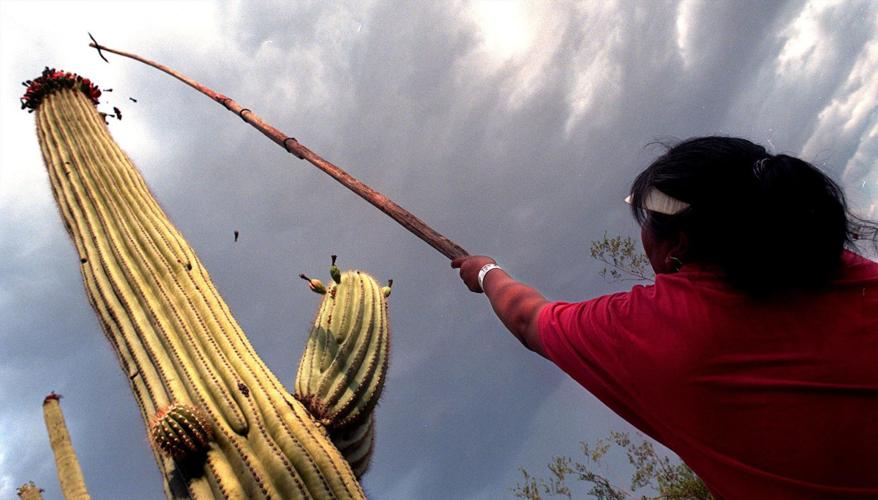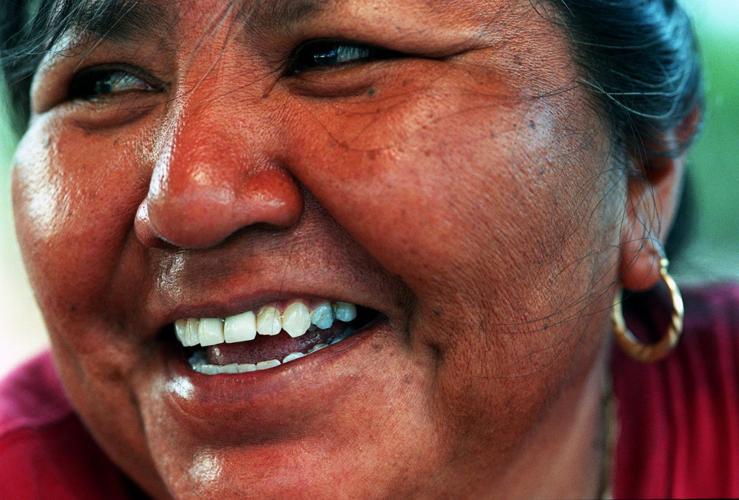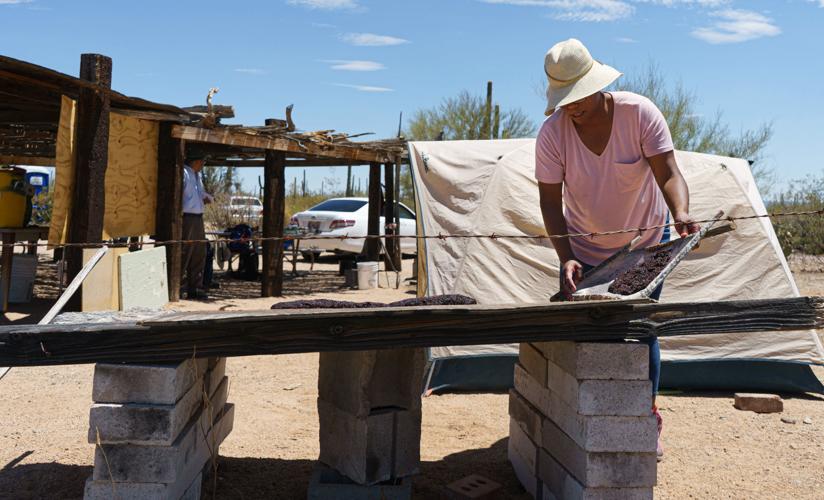Tanisha Tucker has a lot of work to do before the monsoons start.
Tucker, a member of the Tohono O’odham Nation, carries on the ancient custom of plucking the fruit from the giant saguaro cactus, but she must work quickly. Once the rains soak the land, the harvest season is over.
The harvest not only marks the beginning of a new year for the O’odham, it involves a fast and complex process to make a sweet syrup to use for food and ceremonies. The saguaro fruit provides sustenance and ties into a large part of O’odham culture.
“The significance of the saguaro is that, in our songs, our ceremonies and our stories, the saguaros, we consider them people. We believe that they are our ancestors, so they are pretty much like our brothers and sisters,” Tucker says as she sits on a picnic bench in the southwest section of Saguaro National Park West, processing a new batch of picked fruit.

Tanisha Tucker picks seeds away from the saguaro fruit’s fiber.
She is shaded by a large ramada built with railroad ties and covered with saguaro cactus ribs. A small tent and a particle board sit just beyond the ramada. Cinder blocks surround a campfire burning mesquite wood.
Smoke wafts through the ramada as Tucker separates the saguaro seeds and dried up fiber. The Billy Joel song “It’s Still Rock and Roll to Me” plays on a portable radio. Every few minutes, she gets up from the table and stirs the pot of boiling fruit and stokes the fire.
Tucker explains how she carries on despite the passing of her great-great-aunt, Juanita Ahil, and her mother, Stella.
Stella Tucker, who passed away early this year, was well-known in the community for educating the public about the saguaro harvest. Her “harvesting camps” included students, scientists, artists and family. Stella Tucker stressed the importance of the harvest even as her health declined.
“As she started to age, and she was no longer able to pick, that’s when I really started to get involved,” Tucker says. Her mother was adamant “about not letting this tradition die even within the tribe and the youth.”

A 1998 photo shows Stella Tucker using a ku’ipad, made from saguaro ribs, to knock down ripe fruits from the top of a saguaro at Saguaro National Park. Stella’s daughter, Tanisha, has taken over that role now.
As her mother did, Tucker brings people to the camp to learn about harvesting and turning the fruit into syrup and jam.
Recently, 20 middle school students from the San Xavier community came to the camp to learn about the harvest. The kids carried long wooden poles made from saguaro cactus ribs with a small creosote stick tied perpendicular to one end. The little stick is used to knock the fruit off the top of the saguaro.
The kids took turns carrying the poles, and it took some effort to dislodge the fruit and remove the pulp from the pod. They were told to give thanks to the saguaro by leaving the empty fruit pod at the base of the cactus. By the end of the morning, some had their hands and shirts stained red from the fruit.

Stella Tucker, who died this year, was well-known for educating the public about saguaro harvesting.
In the end, everyone got to taste the finished syrup from another batch. They gave thanks again before eating the syrup on a small piece of bread. The kids still giggled and teased each other at the ramada, but no smartphones were seen.
“They act like they’re so not interested and then you get them out there and they’re like, ‘Wow, this is really fun,’” Tucker says. “And then they start to understand it.”
The radio now plays Eric Clapton’s “Wonderful Tonight” as Tucker recalls coming out to the camp since she was a little girl. She remembers once when a mountain lion ran nearby, and when a female Border Patrol agent chased a coyote smuggler along the sandy road. The agent later returned empty-handed and out of breath. “She was all mad too,” Tucker says. “So I was like, ‘You want some water?’ ‘No!’”
Moments like this depend on how soon the monsoon comes. Tucker uses this time wisely because the harvesting could last for several weeks or just one. Frequent rain ferments the fruit, rendering it useless for human consumption. “Nature’s gonna do what it wants to do,” she says.

Tanisha Tucker picks seeds away from the saguaro fruit’s fiber.

Tanisha Tucker lays out the saguaro fruit patties on a board to dry on July 8, 2019, at Saguaro National Park. Once the patties dry, Tucker begins to separate the seeds from the fiber so that they can be used elsewhere.

Fibers and seeds of the saguaro fruit are brought to a boil before they’re taken off the fire and shaped into patties on July 8, 2019.


